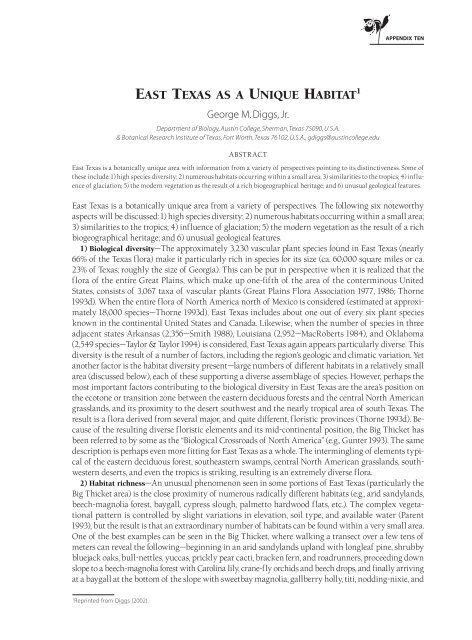Appendices & Glossary - Botanical Research Institute of Texas
Appendices & Glossary - Botanical Research Institute of Texas
Appendices & Glossary - Botanical Research Institute of Texas
You also want an ePaper? Increase the reach of your titles
YUMPU automatically turns print PDFs into web optimized ePapers that Google loves.
EAST TEXAS AS A UNIQUE HABITAT 1<br />
George M. Diggs, Jr.<br />
Department <strong>of</strong> Biology, Austin College, Sherman, <strong>Texas</strong> 75090, U.S.A.<br />
& <strong>Botanical</strong> <strong>Research</strong> <strong>Institute</strong> <strong>of</strong> <strong>Texas</strong>, Fort Worth, <strong>Texas</strong> 76102, U.S.A., gdiggs@austincollege.edu<br />
ABSTRACT<br />
APPENDIX TEN<br />
East <strong>Texas</strong> is a botanically unique area with information from a variety <strong>of</strong> perspectives pointing to its distinctiveness. Some <strong>of</strong><br />
these include: 1) high species diversity; 2) numerous habitats occurring within a small area; 3) similarities to the tropics; 4) influence<br />
<strong>of</strong> glaciation; 5) the modern vegetation as the result <strong>of</strong> a rich biogeographical heritage; and 6) unusual geological features.<br />
East <strong>Texas</strong> is a botanically unique area from a variety <strong>of</strong> perspectives. The following six noteworthy<br />
aspects will be discussed: 1) high species diversity; 2) numerous habitats occurring within a small area;<br />
3) similarities to the tropics; 4) influence <strong>of</strong> glaciation; 5) the modern vegetation as the result <strong>of</strong> a rich<br />
biogeographical heritage; and 6) unusual geological features.<br />
1) Biological diversity—The approximately 3,230 vascular plant species found in East <strong>Texas</strong> (nearly<br />
66% <strong>of</strong> the <strong>Texas</strong> flora) make it particularly rich in species for its size (ca. 60,000 square miles or ca.<br />
23% <strong>of</strong> <strong>Texas</strong>; roughly the size <strong>of</strong> Georgia). This can be put in perspective when it is realized that the<br />
flora <strong>of</strong> the entire Great Plains, which make up one-fifth <strong>of</strong> the area <strong>of</strong> the conterminous United<br />
States, consists <strong>of</strong> 3,067 taxa <strong>of</strong> vascular plants (Great Plains Flora Association 1977, 1986; Thorne<br />
1993d). When the entire flora <strong>of</strong> North America north <strong>of</strong> Mexico is considered (estimated at approximately<br />
18,000 species—Thorne 1993d), East <strong>Texas</strong> includes about one out <strong>of</strong> every six plant species<br />
known in the continental United States and Canada. Likewise, when the number <strong>of</strong> species in three<br />
adjacent states Arkansas (2,356—Smith 1988), Louisiana (2,952—MacRoberts 1984), and Oklahoma<br />
(2,549 species—Taylor & Taylor 1994) is considered, East <strong>Texas</strong> again appears particularly diverse. This<br />
diversity is the result <strong>of</strong> a number <strong>of</strong> factors, including the region’s geologic and climatic variation. Yet<br />
another factor is the habitat diversity present—large numbers <strong>of</strong> different habitats in a relatively small<br />
area (discussed below), each <strong>of</strong> these supporting a diverse assemblage <strong>of</strong> species. However, perhaps the<br />
most important factors contributing to the biological diversity in East <strong>Texas</strong> are the area’s position on<br />
the ecotone or transition zone between the eastern deciduous forests and the central North American<br />
grasslands, and its proximity to the desert southwest and the nearly tropical area <strong>of</strong> south <strong>Texas</strong>. The<br />
result is a flora derived from several major, and quite different, floristic provinces (Thorne 1993d). Because<br />
<strong>of</strong> the resulting diverse floristic elements and its mid-continental position, the Big Thicket has<br />
been referred to by some as the “Biological Crossroads <strong>of</strong> North America” (e.g., Gunter 1993). The same<br />
description is perhaps even more fitting for East <strong>Texas</strong> as a whole. The intermingling <strong>of</strong> elements typical<br />
<strong>of</strong> the eastern deciduous forest, southeastern swamps, central North American grasslands, southwestern<br />
deserts, and even the tropics is striking, resulting is an extremely diverse flora.<br />
2) Habitat richness—An unusual phenomenon seen in some portions <strong>of</strong> East <strong>Texas</strong> (particularly the<br />
Big Thicket area) is the close proximity <strong>of</strong> numerous radically different habitats (e.g., arid sandylands,<br />
beech-magnolia forest, baygall, cypress slough, palmetto hardwood flats, etc.). The complex vegetational<br />
pattern is controlled by slight variations in elevation, soil type, and available water (Parent<br />
1993), but the result is that an extraordinary number <strong>of</strong> habitats can be found within a very small area.<br />
One <strong>of</strong> the best examples can be seen in the Big Thicket, where walking a transect over a few tens <strong>of</strong><br />
meters can reveal the following—beginning in an arid sandylands upland with longleaf pine, shrubby<br />
bluejack oaks, bull-nettles, yuccas, prickly pear cacti, bracken fern, and roadrunners, proceeding down<br />
slope to a beech-magnolia forest with Carolina lily, crane-fly orchids and beech drops, and finally arriving<br />
at a baygall at the bottom <strong>of</strong> the slope with sweetbay magnolia, gallberry holly, titi, nodding-nixie, and<br />
1 Reprinted from Diggs (2002).
















